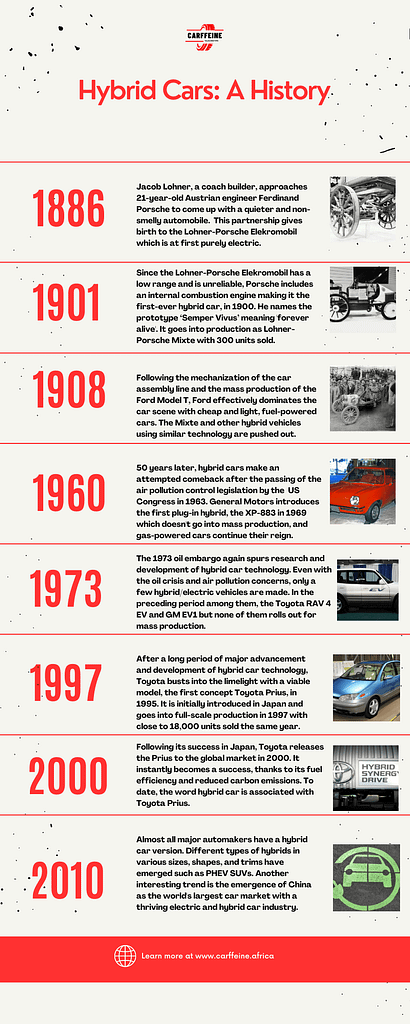This timeline for the history of hybrid cars gives an in-depth view of the evolution of hybrids. It is clear from our previous blogs that hybrid car technology has been in development for over a century.
The streamlining of car assembly, the perfection of the internal combustion engine, and the discovery of more oil fields made it difficult for hybrid cars to break even.
The car became hugely popular over the years. It resulted in the development of cities, road networks, motels, service stations, and oil and steel industries.
Presently, hybrid cars are gracing showrooms. They are actualizing the goals of green driving and efficiency. For the same reason, every car manufacturer worth its salt now has a hybrid car version.
Hybrid Cars’ Timeline.

The car may seem like it has been around forever. However, it is a relatively new invention that was invented and perfected in the late 1800s and early 1900s.
Breakdown
1886 – Jacob Lohner, a coach builder, approaches 21-year-old Austrian engineer Ferdinand Porsche to come up with a quieter and non-smelly automobile. This partnership gives birth to the Lohner-Porsche Elekromobil which is at first purely electric.
1901 – Since the Lohner-Porsche Elekromobil has a low range and is unreliable, Porsche includes an internal combustion engine making it the first-ever hybrid car, in 1900. He names the prototype ‘Semper Vivus’ meaning ‘forever alive’. It goes into production as Lohner-Porsche Mixte with 300 units sold.
1908 – Following the mechanization of the car assembly line and the mass production of the Ford Model T, Ford effectively dominated the car scene with cheap and light, fuel-powered cars. The Mixte and other hybrid vehicles using similar technology are pushed out.
1960 – 50 years later, hybrid cars made an attempted comeback after the passing of the air pollution control legislation by the US Congress in 1963. General Motors introduced the first plug-in hybrid, the XP-883 in 1969 which didn’t go into mass production, and gas-powered cars continue their reign.
1973 – The 1973 oil embargo again spurs research and development of hybrid car technology. Even with the oil crisis and air pollution concerns, only a few hybrid/electric vehicles are made. In the preceding period among them, the Toyota RAV 4 EV and GM EV1 but none of them rolls out for mass production.
1997 – Hybrid Revolution
After a long period of major advancement and development of hybrid car technology, Toyota busts into the limelight with a viable model, the first concept Toyota Prius, in 1995. It is initially introduced in Japan and goes into full-scale production in 1997 with close to 18,000 units sold the same year.
2000 – Following its success in Japan, Toyota releases the Prius to the global market in 2000. It instantly becomes a success, thanks to its fuel efficiency and reduced carbon emissions. To date, the word hybrid car is associated with Toyota Prius.
2010 – Almost all major automakers have a hybrid car version. Different types of hybrids in various sizes, shapes, and trims have emerged such as PHEV SUVs. Another interesting trend is the emergence of China as the world’s largest car market with a thriving electric and hybrid car industry.
There You Have It – The History of Hybrid Cars
As you can see from this history of hybrid cars, we can only anticipate and hope to keep up with the major hybrid car inventions and choices that are on offer or yet to be released. We might actually be spoiled for choice. Green driving is becoming a reality.
Meanwhile, China has joined the auto industry foray, and it is something to look out for. Governments around the world are embracing the changing tide. An important concern for our region and Africa is whether we are ready for the hybrid revolution. It is already here, and I bet most of us have come across a hybrid car.
As economists say that economies of scale translate to lower production costs and higher output, hybrid cars might become cheaper in the near future.

